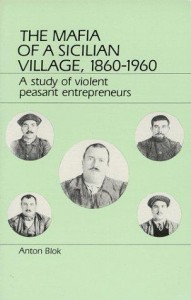 Blok, Anton. 1974. The Mafia of a Sicilian Village, 1860-1960: A Study of Violent Peasant Entrepreneurs. Cambridge: Waveland Press.
Blok, Anton. 1974. The Mafia of a Sicilian Village, 1860-1960: A Study of Violent Peasant Entrepreneurs. Cambridge: Waveland Press.
Anton Blok’s Mafia of a Sicilian Village is one of my favorite books. It shows how “the mafia” in Sicily emerged as network that grew out of a complex political-economic conjuncture over a 100-year period. This massive story is humbly and sparsely told through the life of a Sicilian village of no more than a couple thousand residents. Considering the violence and secrecy surrounding mafia, Blok’s two years of patient ethnographic study paid off: he gained access to the accounts of intimate rivalries, blood feuds, and networks of corruption surrounding this phenomenon. Blok also succeeds in showing mafia’s deep roots in rural Sicilian society. It’s a story about landowners and peasants though never losing sight of the broader societal forces of which these actors are a part. The book is an impeccable example of a study that’s able to show the relations and innerworkings of dialectical and conjunctural forces at various scales. His findings show that mafiosi are, above all, middlemen, power-brokers that not only mediate relations between peasants and the state, but also relations between landowners and peasants. Of course, that’s not all they are…
The rumblings of mafia began in the early 19th century when the Bourbon State moved toward emancipating peasants in an effort to curb the power of the aristocracy. The final vestiges of feudalism were increasingly legislated away—first in 1812 and then in subsequent laws. With the founding of Italian statehood in 1861, reformers sought to create a class of smallholders, but with the same disappointing result as the Bourbon reforms. “Quite unintentionally, Bourbon legislation aided the rise of a new and powerful landed gentry rather than promoting the mergence of a class of smallholders engaged in efficient cultivation” (91). Indeed, the statehood project of land reform was entirely hijacked by a new landed gentry that partly replaced and partly fused with the old aristocracy, creating a wave of enclosures and massive dispossession. “The gradual emergence of what came to be known only later on as ‘mafia’ can be understood in the context of this development in which the central government, the landlords, and the peasants arranged and rearranged themselves in conflict and accommodation” (11).
The landowners were increasingly absent from their holdings, having sought out the opulent aristocratic lifestyle of Palermo and other cities. A class of leaseholders, known as gabelloti, controlled the vast latifondo left behind through the work of their overseers (soprastante) who depended on a team of mounted gunmen called campieri (55). Blok calls the gabelloti and overseers “peasant entrepreneurs,” and it is mainly the rentier gabelloti that led the charge toward full-fledged mafiosi (68). “Physical violence dominated the social relationships through which the large estates were exploited. In this way, mafiosi kept restive peasants in submission, while opening up avenues for upwardly mobile peasants who qualified in the use of violence” (75). The peasantry was still bubbling from the combined effects of the end of feudalism, dispossession, and increasingly radical demands, and the gabelloti responded brutally. The other avenue the gabelloti managed was that connecting peasants (and local politics) with the national state. They served as the organizers and brokers of local-national patron-client ties.
Mafia was born of the tensions between the central government and local landowners on the one hand, and between the latter and peasants on the other. At the same time, however, mafia helped manage these distinct but interrelated tensions and struggles since it provided a specific code through which members of the various social classes and groups arranged themselves. (92)
Blok distinguishes mafia in its 20th Century guise form from its feudal predecessors, who mainly acted as the armed retainers for maintaining the law and order of vested interests in the countryside: “Where as the mediating functions of the latter [i.e. feudal] were minimal and strictly locally phrased, those of the former attain major strength and significance in connection with the impact of the State and the advent of the market” (153). Indeed, Blok positions mafiosi as critical actors for making possible the production and maintenance of market and state relations in this marginal areas of the nascent Italian state:
With the penetration of the State and the market into the Sicilian hinterland in the course of the 19th and 20th centuries, Mafiosi succeeded in dominating the paths linking the local community to the outside world…. The critical leverage of the Mafioso over peasant votes was appreciated by his urban patron, who protected him against the demands of the law, covering up his illegal dealings with a cloak of immunity. (177)
As brokers of a violent type, Mafiosi were poised between the peasants (from whose ranks they sprang) and the State, and succeeded in maintaining a grip on the tension between what have been called [by James Scott] the ‘Little Tradition’ and the ‘Big Tradition’. (179)
Indeed, when the state was strong and particularly repressive—as in Fascism—the mafia largely subsided, only to regain prominence in the post-war era when the need for brokers regained importance amid changing political and economic conditions. Of course, I’m leaving out all the juicy details about how Blok masterfully reconstructs this story. Sorry! It’s well worth a read.

Pingback: Geographies of the Outlaw | Territorial Masquerades